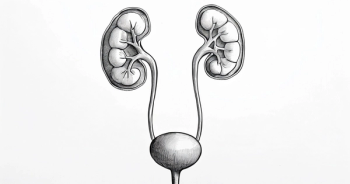
Progression in EGFR+ NSCLC Delayed With Ramucirumab Plus Erlotinib Combination
Progression-free survival, the primary endpoint of the RELAY trial, was significantly improved with frontline ramucirumab in combination with erlotinib compared to placebo plus erlotinib in patients with metastatic <em>EGFR</em>-mutant non–small cell lung cancer.
Maura N. Dickler, MD
Progression-free survival (PFS), the primary endpoint of the RELAY trial (NCT02411448), was significantly improved with frontline ramucirumab (Cyramza) in combination with erlotinib (Tarceva) compared to placebo plus erlotinib in patients with metastatic EGFR-mutant nonsmall cell lung cancer (NSCLC).1
Findings demonstrated that the combination had a similar safety profile compared to what has been previously reported for each agent alone, according to Eli Lilly and Company, the manufacturer of ramucirumab. Hypertension, dermatitis acneiform, and diarrhea were the most common (>5%) grade ≥3 adverse events (AEs) that occurred at a higher rate (≥5% difference) with the combination compared to the placebo arm.
Eli Lilly and Company will submit applications to regulatory agencies later in 2019; full findings will be presented at an upcoming medical meeting.
"We are excited about these results, which show Cyramza plus erlotinib significantly delayed disease progression in this patient population. The RELAY trial is another example of Lilly's deep commitment to providing new treatment options to patients with lung cancer," Maura Dickler, MD, vice president of late phase development of Lilly Oncology, said in the press release. "We would like to thank the patients, investigators and clinical trial sites that are participating in the RELAY study, and we look forward to working with regulatory authorities globally on our submissions."
The international, placebo-controlled, three-part, phase III RELAY trial enrolled 543 patients with stage IVEGFR-mutant NSCLC, including exon 19 deletions and L858R mutations. In part A of the trial, safety and tolerability was assessed with the combination of ramucirumab at 10 mg/kg intravenously (IV) every 2 weeks plus oral erlotinib at 150 mg daily. In part B, patients were randomized to receive the combination of ramucirumab/erlotinib or placebo/erlotinib as a first-line therapy. Treatment was administered until discontinuation criteria were met.
Additionally, there was a third experimental arm (part C) that included IV ramucirumab combined with either oral gefitinib (Iressa) or oral osimertinib (Tagrisso); both TKIs are approved in the frontline setting for patients withEGFR-mutant NSCLC.
To be eligible for enrollment, patients had to have a cytologically or histologically confirmed diagnosis of stage IVEGFR-mutant NSCLC as defined by the American Joint Committee on Cancer Staging Criteria for Lung Cancer, be eligible for first-line erlotinib, at least 1 measurable lesion, and a life expectancy of at least 3 months.
Those with anEGFRT790M mutation, known leptomeningeal carcinomatosis, serious illness condition, ongoing treatment with CYP3A4 inducers or strong inhibitors, ongoing therapy with nonsteroidal anti-inflammatory drugs for ≥2 months, history of gross hemoptysis, significant bleeding disorders, and radiographic evidence of major blood vessel invasion or encasement by cancer, or evidence of intratumor cavitation were excluded from enrolling.
The coprimary endpoint of RELAY was PFS and number of patients with ≥1 treatment-related AEs. Secondary endpoints included overall survival (OS), objective response rate (ORR), disease control rate, duration of response, pharmacokinetics, number of patients with anti-ramucirumab antibodies, change from baseline on the Lung Cancer Symptom Scale, and change from baseline on the EuroQol 5-Dimension, 5-Level Questionnaire.
In December 2014, the FDA approved ramucirumab in combination with docetaxel as a treatment for patients with metastatic NSCLC whose tumor has progressed during or following treatment with platinum-based chemotherapy. The label also stipulates that patients withEGFRorALKaberrations should first receive FDA-approved agents targeting these aberrations prior to ramucirumab.
The approval was based on findings from the phase III REVEL trial, in which the combination led to a 1.4-month improvement in OS versus docetaxel alone. The median OS was 10.5 months in the combination arm versus 9.1 months in single-agent docetaxel arm (HR; 0.857; 95% CI, 0.751-0.98;P= .0235).2
REVEL enrolled 1253 patients with squamous (26.2%) and nonsquamous (73.8%) stage IV disease, who had an ECOG performance status ≤1. Patients were randomized 1:1 to 75 mg/m2of docetaxel in combination with 10 mg/kg of ramucirumab (n = 628) or placebo (n = 625) on day 1 of a 3-week cycle. Treatment was administered until disease progression or unacceptable toxicity.
Additional results showed that the median PFS was also improved with the combination of ramucirumab and docetaxel at 4.5 months compared with 3.0 months for docetaxel alone (HR, 0.762; 95% CI, 0.68-0.86;P<.0001).
References:
- Lilly's Cyramza® (Ramucirumab) Phase 3 RELAY Trial Met Primary Endpoint, Significantly Improving Progression-Free Survival in First-Line Treatment of Patients With Metastatic EGFR-Mutated Non-Small Cell Lung Cancer. Eli Lilly and Company. Published March 12, 2019. https://bit.ly/2UtkdPW. Accessed March 12, 2019.
- Garon EB, Ciuleanu T-E, Arrieta O, et al. Ramucirumab plus docetaxel versus placebo plus docetaxel for second-line treatment of stage IV non-small-cell lung cancer after disease progression on platinum-based therapy (REVEL): a multicentre, double-blind, randomised phase 3 trial.Lancet Oncol. 2014;384(9944):665-673. doi: 10.1016/S0140-6736(14)60845-X.









































